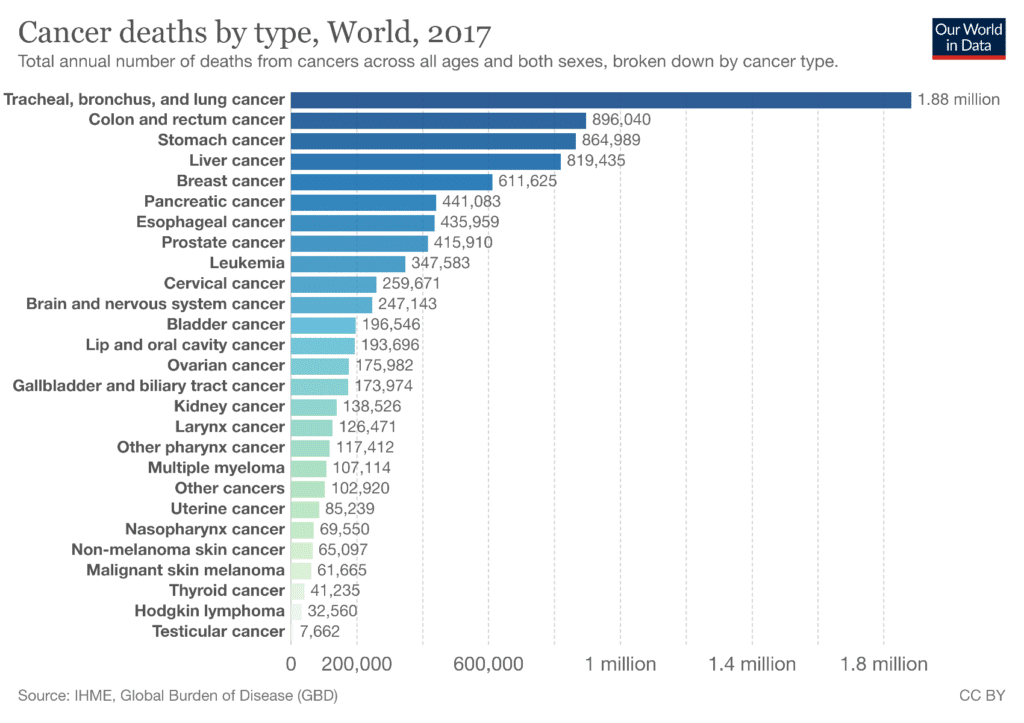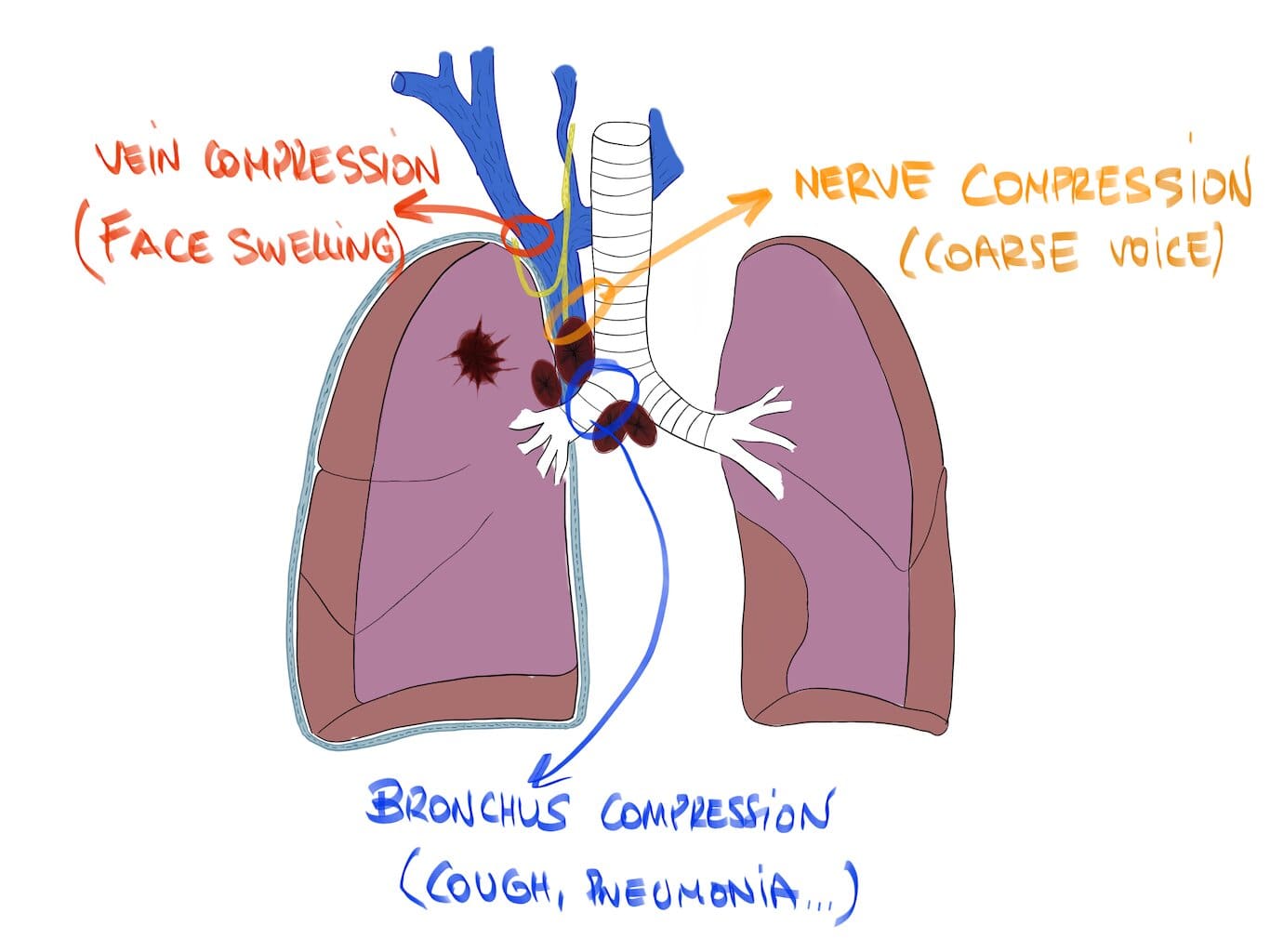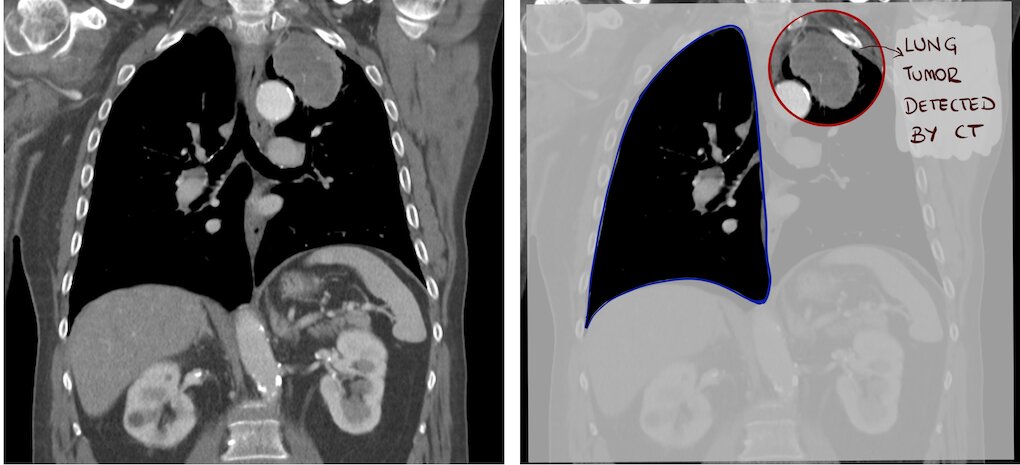Lung cancer kills more people than prostate and breast cancer combined, even though it is less frequent than each of them. That’s because lung cancer is a really aggressive one. Fortunately, there have been some breakthroughs in the last years, so we can treat even metastatic lung cancer more efficiently.
What is lung cancer?
Lung cancer is one of the most common and deadly cancers. If we take 100 random people, around 7 of them will suffer from lung cancer. If we only choose smokers, the number is higher. Also, lung cancer is the leading cause of cancer death: over 25% of cancer deaths are due to lung cancer. It kills more people than the next 3 cancer types combined (colon, prostate, and breast cancer).

Lung cancer usually affects people over 60, mostly smokers, ex-smokers, and passive smokers. 80-90% of patients with lung cancer have a history of smoking.
What are the symptoms of lung cancer?
Some symptoms are due to a growing mass in your lung that grows and compresses other structures. Other symptoms are due to metabolic, or general, symptoms.
Local symptoms
The most frequent symptoms are cough and breathlessness. Depending on which structure it affects, there’ll be other symptoms. For example, if the tumor narrows the bronchus it will cause wheezing, pneumonia, and blood when you cough (hemoptysis).
If the tumor compresses the surrounding nerves, it will cause a hoarse voice and trouble swallowing (dysphagia).
Finally, if the tumor compresses the superior cava vein, it will cause swelling of the face and neck. This is called superior cava vein syndrome and it’s more common with tumors of the right side.

General symptoms
The other symptoms are “general” symptoms, they don’t happen inside the chest. They are caused by metabolic processes or low oxygen levels, from the tumor. One of the most surprising is “finger clubbing”: your fingertips change their form. They become rounded and larger, like drumsticks.

Because the tumor eats away some of your glucose, you may feel fatigued, with a lack of energy. For the same reason, it’s common to lose weight. These symptoms are part of what we call “constitutional syndrome”. When a person has constitutional syndrome and we don’t know why we need to look for hidden tumors.
What are the types of lung cancer?
There are two main types: small cell cancer and non-small cell cancer.
- Small cell cancer usually spreads to the lymph nodes, so its prognosis is worse. Because it is so aggressive, we can’t remove it through surgery, so it requires radiotherapy and chemotherapy.
- Non-small cell cancer is much less aggressive. Fortunately, it’s also more frequent (87% of cases) and have a better prognosis than small cell. If we diagnose it early, before it has spread, we can remove it with surgery.
There are also other types of lung tumors with lower aggressivity, like carcinoid tumors. They sometimes behave like benign tumors, except that they can secrete hormones and other substances.
How do you diagnose lung cancer?
X-ray
The first test to detect lung cancer is x-ray. An X-ray shows if there is a nodule or a mass in your lungs. It’s pretty accurate most of the time. However, it can miss some small nodules, especially if they grow in some “hidden areas”.
CT
We use CT when x-ray is not enough and we still have doubts. The CT shows any nodules in the lungs, but also, it will show if the mass is infiltrating other structures. It will tell us if the are lymph nodes or metastases as well.
Another benefit of CT is it can be used to guide a biopsy, so that we take a sample from the nodule.

PET-CT
It is, as its name indicates, a CT and a PET. So, what is the PET for?
Well, sometimes the CT can detect some alteration, let’s say a nodule. But it can’t tell us if it’s cancer or not. What if it was already there 20 years ago? Like a granuloma, which is a benign nodule. That’s when the PET comes in useful. PET will detect the metabolic activity of a lesion by finding wether it is consuming glucose. If it’s “cold” it’s probably not cancer.
Bronchoscopy
It means getting a tube inside your nose, trachea, and bronchi with a small camera attached to its tip. That way, we get a look at the tumor. And we can biopsy it too. This option is better for central tumors. Peripheral tumors are hard to reach through bronchoscopy, and why we use CT-guided biopsies on them.

Mediastinoscopy
It’s useful to to evaluate your lymph nodes in your mediastinum.
Imagine you have some lymph nodes that are slightly bigger than normal, but not too much. They may or may not be malignant. The PET-CT can sometimes help us determine if they are. If those nodes show increased metabolism, they are likely malignant. But sometimes the PET-CT will be inconclusive too. Is it 100% necessary to be sure about those nodes? Well, in some cases that information can be crucial. It can change the management of the patient:
- If you only have a localized tumor, you may treat it with surgery alone.
- But if those lymph nodes are affected they need to be treated too, so they will require radiotherapy or chemotherapy.
In these cases, mediastinoscopy can obtain a sample from those lymph nodes to find out for sure whether they are affected or not. It consists of a tiny camera at the tip of a thin tube that is inserted into your mediastinum in the middle of your thorax.
Staging
Before we start treating lung cancer, we need to know how much it has spread. Are there other nodules? Lymph nodes affected= Are the metastases?
If the tumor is circumscribed, with no lymph nodes and no metastases, it can be treated with surgery. For more advanced tumors, with mediastinum lymph nodes, they’ll need radiotherapy. And for really advanced tumors, those with metastases, we’ll need to use chemotherapy or some of the new therapies.
How do you treat lung cancer?
We choose different treatments depending on the staging (how much the tumor has spread), the tumor type and the patient’s health state.
Surgery
Surgery is a good choice for tumors that are small, well-circumscribed, and with no spread signs. These tumors are usually non-small cell tumors. The patient must be able to withstand surgery, too, which requires good general health and lung capacity.
Radiotherapy
Radiotherapy is a useful in many cases. For example, when there are lymph nodes affected, whether it’s a small or non-small cell cancer. The radiotherapy field can include both the tumor and the lymph nodes, treating them both.
In some cases, radiotherapy is used to improve the symptoms, even if it won’t cure the patient. We call it palliative radiotherapy in those cases.
It’s also a good option for patients that will not withstand surgery due to their fragile state of health. In those cases, there is an even better modality of radiotherapy for them: stereotactic radiotherapy.
Stereotactic therapy
For patients that cannot undergo surgery, this is a great option if the tumor is small and hasn’t spread. It consists of a highly focused beam of radiotherapy. They apply it to a much smaller area than conventional radiotherapy, but with a higher intensity, like a “laser”.
Chemotherapy
The required option if there are distant metastases. The chemotherapy agents travel through your blood and can reach distant organs through it.
It can be used by itself or together with radiotherapy. Sometimes, we use it before surgery, to see if the tumor will shrink. In those cases, we call it neoadjuvant chemotherapy. Or, it can be used after surgery, to decrease the chances that it will come back (adjuvant chemotherapy).
Most small cell carcinomas require chemotherapy (with or without radiotherapy).
New Therapies
In the last years, scientists have discovered some new powerful treatments for advanced lung cancer. They are targeted therapies and immunotherapy
Targeted therapies
Targeted therapies are drugs that are aimed against specific proteins of a tumor. They will only attack those cells with a certain protein on their surface. Instead, they won’t attack your own healthy ones, so they have less side effects. Before using these therapies, we must make sure that the tumor has the right proteins.
One example is Bevacizumab. It targets VEGF protein, preventing the tumor from getting extra blood supply, so that it can’t grow.
Immunotherapy
Cancer happens because some malignant cells elude our immune response. Normally, our immune response can defend against malignant cells. In fact, every day our immune system kills several “baby tumors” before they can grow and become cancer. Only when they find how to trick our immune system, do we get cancer. With immunotherapy, we reactive our system, so that it will fight those cells again.
Sources
Graphics: https://ourworldindata.org/
Statistics: https://lungevity.org/
Leave a Reply